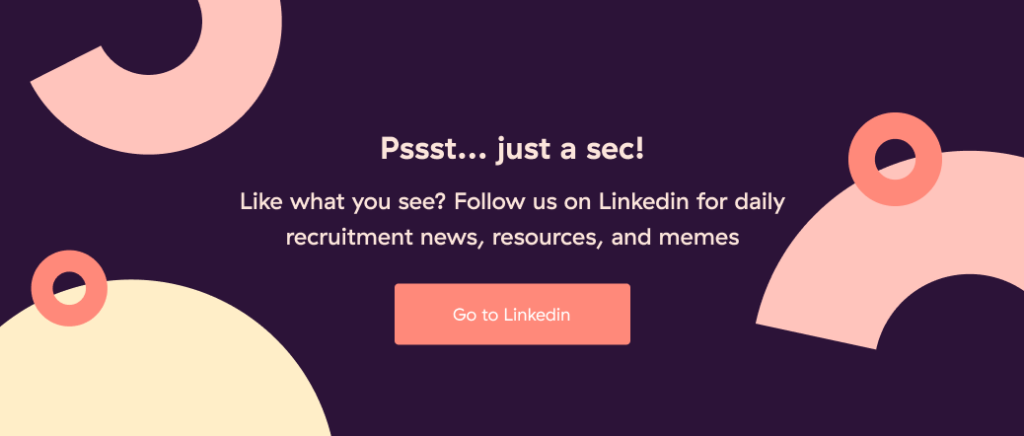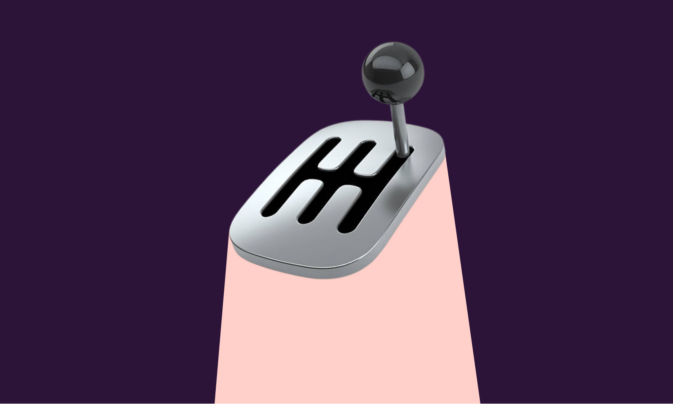Put ten recruiters in a room and ask them their worst nightmare. We’d bet a fair few would say it’s making a hire that turns out to be rubbish. Because nothing hurts more than finding out your rockstar candidate was actually a bad hire.
And with nearly three-quarters of companies (74%) falling foul to bad hires, it’s a problem we want to help solve. In this article, we’ll show you how to prevent bad hires by looking at exactly what they are, what causes them, and three easy ways to fix them.
Time to get into it!
What is a Bad Hire?
Put simply, a bad hire is a new employee that isn’t a good fit for their role or the wider business.
Many people only associate bad hires with employees who quickly leave the business. But, in truth, a bad hire could also be someone who is under-performing or is a poor cultural fit.
Most of the time, bad hires aren’t obvious during the recruitment process. After all, if they were, you wouldn’t hire them. It’s only after they have been in the role for a few weeks or months that a bad hire presents themselves.
Another common misconception is that a bad hire is a one-way problem. The business may love a new employee, but the employee may not love the company back and choose to leave. Companies may need to do some introspection in these situations as they may have caused the bad hire themselves.

What’s The Impact of a Bad Hire? How Much Does a Bad Hire Cost?
So, what’s the cost of hiring the wrong person? While it’s not an exact science, it’s pretty easy to determine that making a bad hire is costly for any business.
Let’s start with the most common recruitment metric, cost to hire. Recent data suggests that, on average, it costs $4,425 to hire a new employee. If you make a bad hire, that’s money instantly down the drain!
But, the cost to hire metric doesn’t tell the whole story. Making a bad hire also has the following knock-on impacts:
- Loss of Productivity – While you have that bad hire in place, your business won’t have been at its most productive. More often than not, bad hires don’t perform the way you had hoped, meaning you’re losing money against the value you expected.
In some roles, the cost is easy to track. For example, if your new SDR hire was only 50% effective and you expected them to secure $2,000 of sales per day – they could be costing you up to $1,000 a day through poor productivity. - The Cost of an Open Vacancy – Both before and after a bad hire, you will have a gap within your organization. A vacancy is only created if there is already a hole that needs filling, so when a bad hire leaves the business, the hole is reopened.
Research suggests that the average open vacancy costs organizations just over $98 a day. Depending on your average time to hire, that can quickly become very expensive. - The Work of a Re-Hire – Once you make a hire, there’s a lot of investment to get them up to speed. Costs are incurred through training courses, company benefits, and the time it takes other staff to offer support.
A bad hire not only incurs these costs themselves, but once they need replacing, you’ll be incurring them again with someone new. Fixed costs (i.e. training courses) are easy to quantify but have a think about the ‘time’ cost of replacing a bad hire. - Loss of Customers – Lastly, in the worst circumstances, a bad hire may lead to you losing valuable customers. This may be linked directly to the performance of the bad hire or could be a consequence of general under-staffing.
Especially if it’s a big fish customer, the financial consequence could be huge and could be compounded by reputation damage.
By combining these factors, it’s easy to see that a bad hire can be very costly for any business. Next, take the time to assess what a bad hire means for you, especially if you’re considering investing in ways to prevent them from happening.
How Do You Know If You’ve Made a Bad Hire?
The only thing worse than making a bad hire is not realizing you’ve made one. Given the costs of a bad hire, you want to ensure you quickly identify an employee who isn’t the right fit.
Bad hires look different every time. So, here are ten red flags to look out for in your business:
| # | 10 Examples of Red Flags that Can Help You Spot a Bad Hire |
| 1. | The quality of work is not up to standard. You can measure this using KPIs or quality assurance practices. |
| 2. | The employee is late to meetings, or worse, doesn’t turn up for work at all. |
| 3. | The employee has a bad attitude to change and isn’t motivated to succeed. |
| 4. | Mistakes are commonly made, with the same mistakes re-occurring even after further training. |
| 5. | The employee cannot perform skills they have claimed to have on their resume. |
| 6. | Feedback from other employees is poor during the probation period. |
| 7. | Other employees actively avoid/do not want to work with the new employee. |
| 8. | The employee does not embrace the company culture and is disruptive. |
| 9. | The employee is overly critical of the company’s ways of working. |
| 10. | Customers complain about the employee, either in their quality of work or their attitude. |
If your new employee exhibits any of these red flags, you may have a bad hire on your hand. But don’t be hasty! First, you’ll want to follow this up in your probation or disciplinary process to ensure there’s no easy fix.
While every recruitment professional can expect the odd bad hire, there may be more to it if you see several bad hire situations. Let’s take a look at exactly what causes a bad hire.

What Causes a Bad Hire?
Consistent bad hires usually point to the recruitment process itself. While it may be a hard pill to swallow, sometimes, as recruitment professionals, you have to look at what you’re doing to ensure you’re actively preventing bad hires.
If you see many bad hires come through, here’s three things that may be causing it:
- Lack of Standardized Hiring Processes. First and foremost, you need to ensure your hiring processes are top-notch. This covers everything from the job specs you put out to your interview techniques.
If your process is incomplete, you create large opportunities for amazing candidates to fall through the cracks. On the flip side, by creating an inconsistent playing field, bad candidates look better and ‘trick’ you into hiring them. - Inadequate Talent Pool. If you see a number of bad hires crop up, there’s a chance you may simply be fishing in the wrong pool. To attract better candidates, you may need to change your recruiting parameters. This could mean being flexible on location, accepting different skills sets, or offering a more competitive package.
After all, the best talent wants the best working conditions and the best rewards, so you need to ensure you can compete in the market. - Poor Candidate Evaluation. Many businesses fail to effectively evaluate their candidates. After all, as a hiring manager, you can’t know the exact skills every single role needs, so you rely on generic job roles and professional-looking resumes to make a decision.
And when 67% of job seekers admit to attempting to bend the recruitment rules, a lack of proper, rigorous evaluation inevitably leads to bad hires.
How to Fix Bad Hires – 3 Tips For Success
If any of the bad-hire causes ring a bell, the good news is we’ve got some fixes. Here are three tips for eliminating bad hires to ensure your recruitment is always a success.
#1 – Fix Your Hiring Process with Innovative Strategies
First, we’d recommend taking a long, hard look at your end-to-end recruitment process. Getting your recruitment strategy right is the foundation for great hiring and will massively help reduce the risk of a bad hire.
But, getting your strategy right takes time, it doesn’t just happen overnight. To help you get started, here are the steps we think you should take:
- First, take a look at our recruitment strategies guide. We guide you through a number of popular ways to improve your process, which are proven to work in the age of digital hiring.
- Next, read up on these three key topics – interviewer bias, equality & diversity in recruitment, and employee selection. By removing interviewer bias and boosting equality & diversity, you’ll ensure you only choose candidates based on their merits. These techniques will ensure you avoid the wrong candidates and reduce the risk of bad hires.
- Once you’re fully in the know, we’d recommend trying out some new techniques in your business. Don’t be afraid to try something new, even if it turns out wrong – every step you take is one step closer to eliminating bad hires!
#2 – Engage with Better Candidates
Let’s dispel a myth. While there’s hot competition for talent, amazing candidates are always in the job market. If you’ve had a string of disappointing hires, you need to start talking to better talent and make yourself more attractive.
First, make sure you’ve thoroughly evaluated your talent gaps to know precisely the level of candidate you need. Next, do some research into talent pools and talent acquisition to ensure you’re positioning yourself correctly with the top candidates.
Lastly, get online and ensure that what you’re offering is competitive in the market. You’re always going to get bad hires if you don’t give the best people what they expect. Here are some excellent salary checking resources for different countries:
- US Job Market – Payscale
- UK Job Market – TotalJobs
- Australian Job Market – Seek
- European Job Market – PayLab
#3 – Evaluate Candidate Performance With Skills Testing
The most common symptom of a bad hire is someone who simply can’t do the job. We’re here to tell you that you no longer need to take this risk – you just need to add skills testing to your recruitment process.
Rather than just asking a candidate to submit a resume and attend an interview, why not get them to show you what they’ve really got? Here are three reasons why skills testing is excellent for eliminating bad hires:
- You make data-driven decisions by assessing candidates on their actual abilities. Candidates have nowhere to hide and prove they have the skills you need to do the role!
- Setting up a skills test is super quick and easy. In fact, with Toggl Hire, it takes just three clicks to set up a Smart Test for your chosen job role, with thousands of expert-created questions ready to be used from our question library. Give yourself more time to spot bad hires!
- It delivers a great candidate experience. Candidates have the opportunity to show off what makes them great, as well as receive instant feedback on their performance and the next steps. This helps you attract high-quality, engaging candidates!
Sounds pretty good, right? Check out how we do it at Toggl Hire and remove the risk of bad hires by thoroughly assessing candidates!
Summary
With nearly three-quarters of companies (74%) reporting that they’ve made bad hires, it’s a problem that many businesses face. Whether it’s a one-off or a regular occurrence, bad hires cost businesses a lot more money than simply the average hiring cost ($4,425).
If you’re falling foul to regular bad hires, you may need to refresh your end-to-end hiring processes. One of the biggest reasons businesses make bad hires is because they fail to assess candidate skills accurately. If that sounds like you, check out how Toggl Hire can put your candidates to the test and help you make better, data-driven hiring decisions.
James Elliott is a Strategy Manager and Writer from London, UK. When not working on the day job, James writes on a variety of business and project management topics with a focus on content that enables readers to take action and improve their ways of working. You can check out James’ work on his website or by connecting on LinkedIn.


